Surprise !?!?!
After some three decades of time spent wandering the forests regularly, one is not expecting surprises. But, it does happen! And, when surprises do happen, it usually is a bumper.
One such surprise awaited me when I was visiting the Sakrebyle Elephant Camp near Shimoga. A colleague of mine walked up to me and started describing something weird that he saw on the ground near the kitchen building. He tried describing it to me but failed to answer all the questions I posed. In a flash, he pulled out his phone and showed me a picture, almost as if to say – ‘Here you go -hope this answers all your questions!’
Of course, I wouldn’t blame him for his reaction. For, the subject under consideration was really weird. But, the moment I saw the picture, without uttering another word, I walked hurriedly to the spot, in spite of knowing very well that the object would remain there for quite some time. I was truly amazed at what I saw; my jaw dropped! The object I was staring at, was the flower of the Elephant Foot Yam!
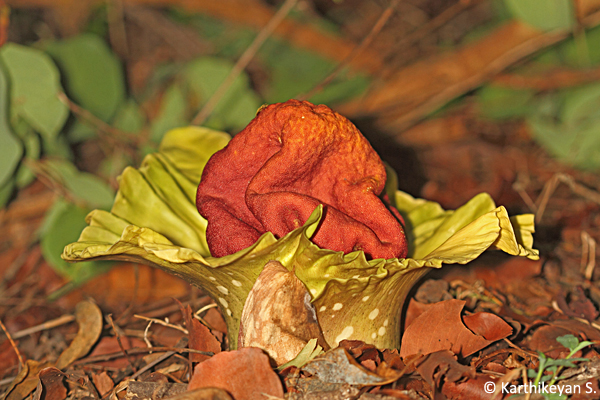
I was simply mesmerized by the sheer beauty of the flower. Though I had briefly seen this from a moving vehicle in the past this was the first time I was seeing it from close quarters. Ample time was spent looking at the flower, peering inside it and feeling the texture. Driven by curiosity, I also bent down to smell it.
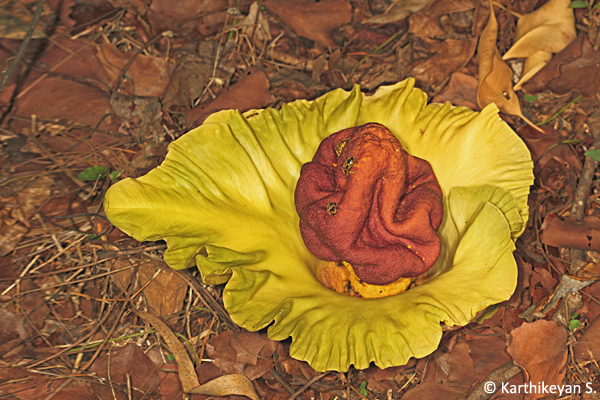
The last act was one that I would want to forget in a hurry. For, the flower did not have a pleasant fragrance, but to the contrary. That said, I did not find it particularly repulsive as made out by many others – may be, I have a better tolerance to such odours or perhaps some people’s noses are too sensitive? What I realized was that the plant had an odour to go with its appearance – one of rotting flesh!
Even as I began thinking of possible pollinators of this strange flower, I saw black coloured beetles coated with golden yellow pollen crawl out.
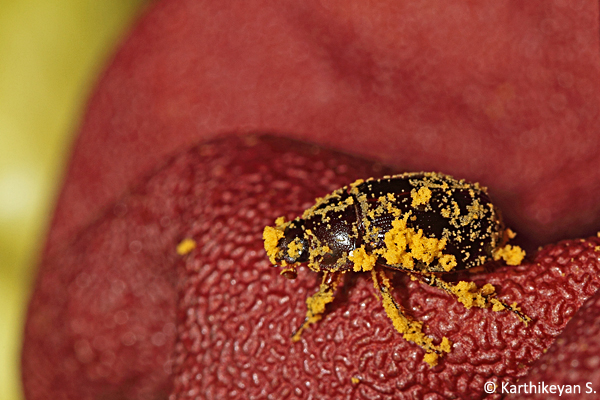
This prompted me to explore the flower a little more, particularly to find out what the large maroon flesh–like knob was hiding beneath it. A cursory peep inside and I saw the spike covered with scale-like structures with bright yellow powder (read pollen) attached to them. These were the male flowers.
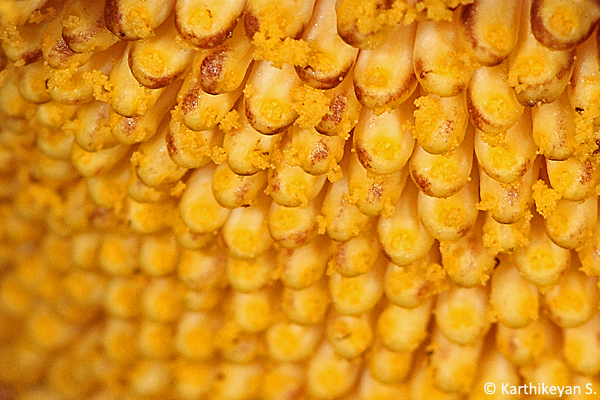
I peered deeper and I saw that the spike just below the male flowers had several little yellow heads on stalks – these were the female flowers.
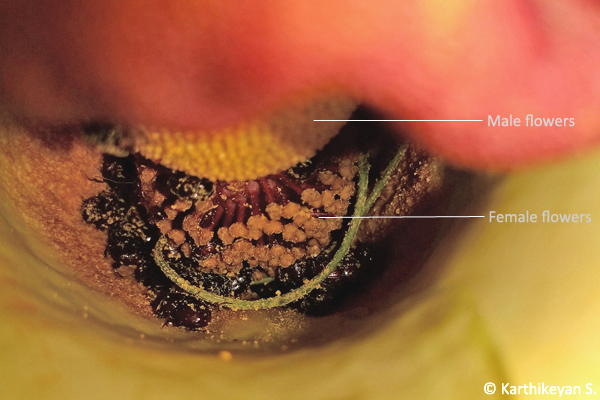
In this particular flower, the male flowers were already in bloom and had released pollen which the beetles were inadvertently carrying on their body.
The female flowers are receptive for a short period and the pollinators (in this case, possibly beetles) must be attracted. Beetles that were inside the flowers must have been drawn to the flower owing to the odour. Once the female flowers are pollinated they are no longer receptive.
The flower ensures that the pollinators hang around using an irresistible odour (of rotting flesh) and a temperature that is higher than the ambient temperature. At about this time the male flowers bloom and produce large quantities of pollen coating the pollinators who then fly away to another flower with a strong odour and repeat the process.
The strategy of staggered flowering of male and female flowers is very interesting indeed. This is very essential to prevent self pollination – Nature is truly amazing!
For many, the flower may be a rarity. But the plant itself may be familiar to those with discerning eyes. Keep an eye open on the undergrowth in the forest and you have a good chance of seeing this plant. The Elephant Foot Yam produces but just a single leaf split into multiple leaflets borne on a dark green stem with pale green blotches. This makes it particularly noticeable.
Amorphophallus paeoniifolius or the Elephant Foot Yam as it is popularly known is further familiar as the tuber is used as a vegetable (suvarnagadde in Kannada; sooran in Hindi) and possibly many of us have eaten it – I have for a fact! What’s more? It is attributed with many medicinal properties. This plant has a wide distribution. It is known to occur from India, all the way east to Australia!
When we bite into that tasty preparation of the Elephant Foot Yam the next time, let us spare a thought to this amazing flower, its adaptations and the tricks that it uses to trap pollinators!